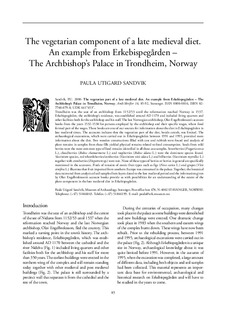The vegetarian component of a late medieval diet. An example from Erkebispegården – the Archbishop’s palace in Trondheim, Norway
Chapter, Peer reviewed
Permanent lenke
http://hdl.handle.net/11250/181427Utgivelsesdato
2000Metadata
Vis full innførselSamlinger
- AmS-Skrifter [10]
Originalversjon
Sandvik, P.U. (2000). The vegetarian component of a late medieval diet. An example from Erkebispegården – The Archbishop’s Palace in Trondheim, Norway. In : L. Selsing (ed.) Norwegian quaternary botany 2000, s. 85-92. Stavanger : Arkeologisk MuseumSammendrag
Trondheim was the seat of an archbishop from 1152/53 until the reformation reached Norway in 1537.
Erkebispegården, the archbishop’s residence, was established around AD 1170 and included living quarters and
other facilities both for the archbishop and his staff. The last Norwegian archbishop, Olav Engelbrektsson’s account
books from the years 1532-1538 list persons employed by the archbishop and their specific wages, where food
formed part of the wages. These books are one of our sources for information about the diet in Erkebispegården in
late medieval times. The accounts indicate that the vegetarian part of the diet, beside cereals, was limited. The
archaeological excavations, which were carried out in Erkebispegården between 1991 and 1995, provided more
information about the diet. Two wooden constructions filled with cess and rubbish were found and analysis of
plant remains in samples from these fills yielded physical remains related to food consumption. Seeds from wild
berries were the most common type of food remains identified in all these cess samples. Strawberries (Fragaria vesca
L.), cloudberries (Rubus chamaemorus L.) and raspberries (Rubus idaeus L.) were the dominant species found.
Vaccinium species, red whortleberries/cowberries (Vaccinium vitis-idaea L.) and bilberries (Vaccinium myrtillus L.)
together with crowberries (Empetrum sp.) were rare. None of these types of berries or berries in general are specifically
mentioned in the accounts. Finds of remains of exotic fruit types such as figs (Ficus carica L.) and grapes (Vitis
vinifera L.) illustrate that fruit imported from southern Europe was consumed in the palace. Together, the botanical
data recovered from analysis of soil samples from layers dated to the late medieval period and the information given
by Olav Engelbrektsson’s account books provide us with possibilities for an understanding of the extent of the
plant component in the late medieval diet in Erkebispegården.
